Top 11 Remote Collaboration Tools to Boost Team Productivity
- shems sheikh
- Jun 10
- 16 min read
Unlocking Team Synergy: A Guide to Remote Collaboration Tools
Effective remote collaboration hinges on the right tools. This guide explores 11 leading platforms, providing practical insights to help your team thrive in a virtual workspace. We'll go beyond marketing hype, offering real-world experience with each tool. This listicle helps you navigate the crowded market of remote collaboration tools, offering clear guidance for product managers, designers, developers, marketing teams, and other remote teams. We cut through the noise to pinpoint the perfect solution for your specific needs.
This in-depth review covers:
Beep
Slack
Microsoft Teams
Zoom
Asana
Trello
Miro
Google Workspace
Notion
Basecamp
Monday.com
We'll examine each platform's strengths and weaknesses, pricing, integrations, and ideal use cases. You'll learn from our hands-on experience, understanding which tools excel in specific scenarios. This practical advice helps you bypass generic feature lists and get straight to actionable information. Forget promotional material; we focus on the real-world implications of using these remote collaboration tools.
1. Beep
Beep streamlines website feedback and collaboration, making it a powerful remote collaboration tool. It shines by letting users leave comments directly on live websites with automatically captured screenshots. This visual approach clarifies feedback and minimizes misunderstandings, a common pain point in remote teams. Forget endless email chains or confusing chat messages - Beep provides context and clarity. This focus makes it ideal for web development teams, designers, and product managers who need a precise and efficient feedback loop.
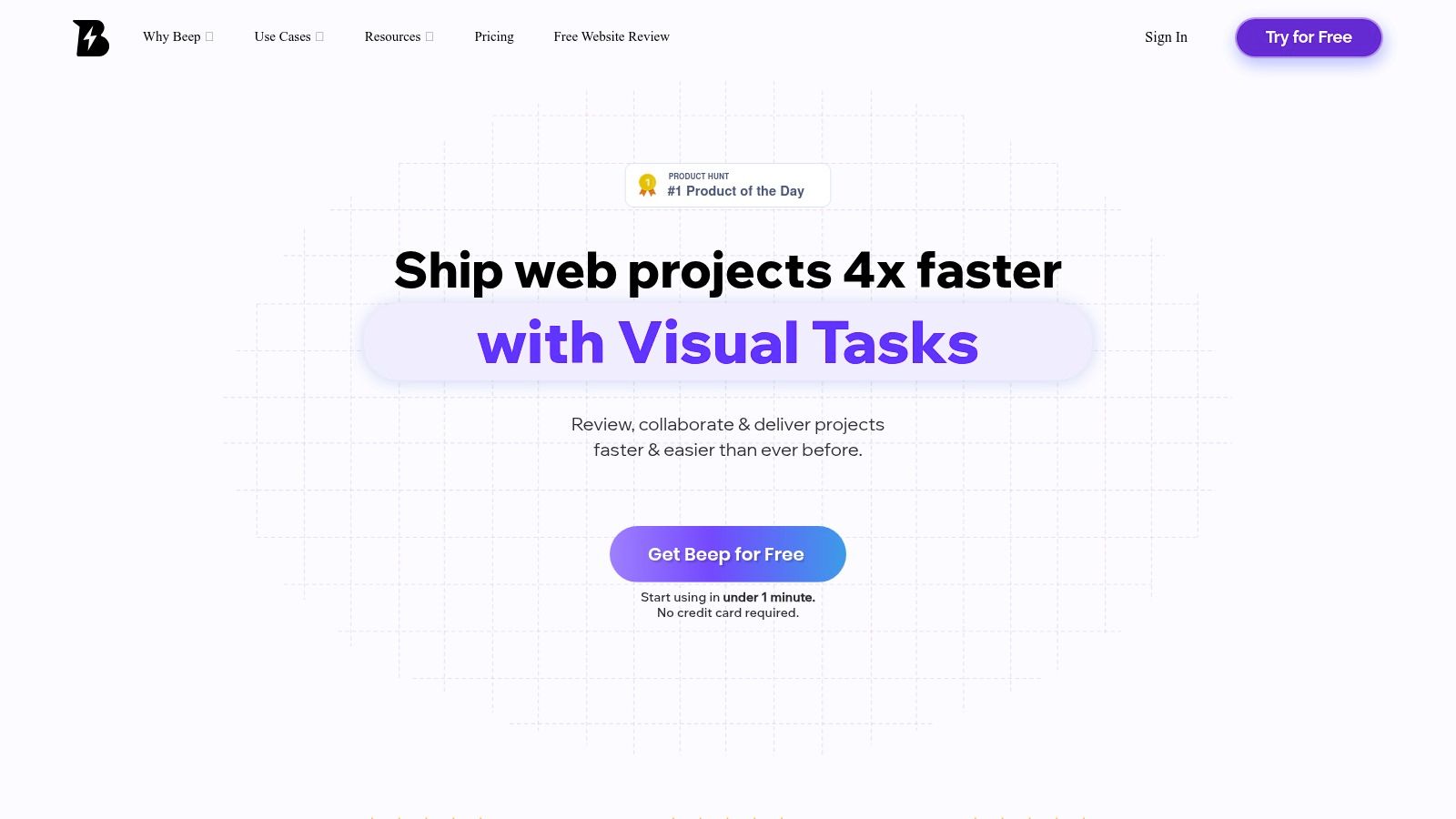
Its built-in Kanban board keeps feedback organized and actionable. Converting comments into trackable tasks prevents them from getting lost and accelerates project completion. Beep's integrations with tools like Slack, Jira, Notion, and Zapier weave it seamlessly into existing workflows, a major plus for remote teams juggling multiple platforms. Setting up is also refreshingly simple - no credit card is required to get started.
Pros and Cons
Pros:
Visual feedback directly on live websites.
Automatic screenshots for added clarity.
Integrated Kanban board for task management.
Seamless integration with popular tools.
Easy setup with no credit card required.
Cons:
Primarily focused on web project reviews.
Some advanced integrations may still be under development.
Practical Use Cases and Implementation
Beep is highly effective for:
Website design reviews.
User testing feedback collection.
Bug tracking and management.
Client collaboration on web projects.
To get started, simply install the browser extension and invite your team. Begin leaving comments directly on your website and watch the feedback process transform. While the core features are free, future pricing plans may introduce additional features and user limits.
Why Beep Earns its Spot
Beep excels at simplifying and streamlining website feedback. Its visual approach and seamless integrations make it a standout choice for remote teams struggling with asynchronous communication. While primarily web-focused, its core strength of clear, contextual feedback makes it a valuable addition to any remote team's toolkit. Check out Beep at https://www.justbeepit.com.
2. Slack
Slack is a robust communication platform designed to streamline team collaboration. It achieves this through organized channels, direct messaging, and a host of integrations. Slack supports real-time messaging, file sharing, and integrates with numerous third-party apps to enhance workflow efficiency. It effectively replaces email for internal communication, fostering quicker responses and a more connected team.
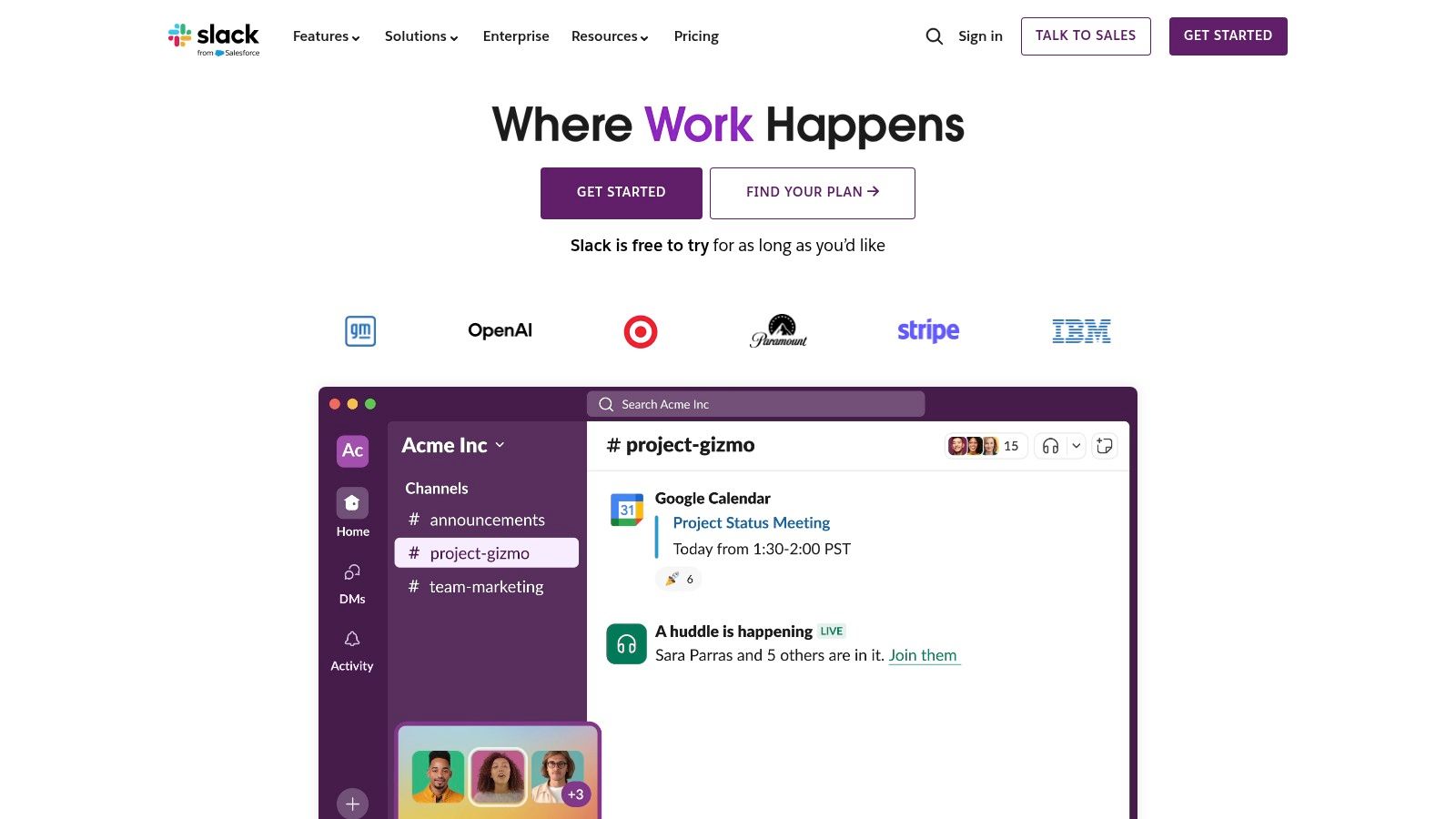
Its channel-based system keeps conversations organized by project, team, or topic. Threaded replies within channels prevent discussions from becoming unwieldy. The searchable archive makes it easy to find past information, a significant advantage over email. Slack also offers voice and video calls with screen sharing, facilitating quick meetings and collaborative work sessions.
Pros and Cons
Pros:
Intuitive interface with customizable themes.
Robust search functionality.
Extensive app integrations (over 2,400).
Flexible notification settings.
Strong community support.
Cons:
Free plan limitations on message history and integrations.
Potential for notification overload.
Can become complex to manage with numerous channels.
Practical Use Cases and Implementation
Slack is highly effective for:
Daily team communication.
Project management updates.
Quick questions and answers.
Remote team meetings.
Client communication (with shared channels).
Implementation is straightforward: create a workspace, invite your team, and establish relevant channels. Encourage team members to customize their notification settings to avoid distractions. Integrating key tools like Google Drive, Asana, or Trello enhances workflow efficiency.
Why Slack Earns its Spot
Slack’s comprehensive features and intuitive interface make it a central hub for remote collaboration. Its ability to streamline communication, centralize information, and integrate with numerous tools makes it a valuable asset. While the free plan has limitations, the paid plans offer significant value for remote teams seeking enhanced communication and collaboration. Check out Slack at https://slack.com/.
3. Microsoft Teams
Microsoft Teams has become a central hub for many remote teams, combining chat, video meetings, file storage, and app integration. Its deep integration with Microsoft 365 makes it a natural choice for organizations already invested in that ecosystem. Teams shines in its ability to consolidate communication and collaboration into a single platform, reducing the need to constantly switch between different applications. This streamlined approach is a major productivity boost for remote teams. You can explore further tools and resources for remote collaboration in articles like this one focusing on the top tools for 2025: Learn more about Microsoft Teams and other tools.

Persistent chat with threaded conversations keeps communication organized, while high-quality video conferencing facilitates face-to-face interaction. Real-time document collaboration within the platform eliminates version control headaches. The integration with other Microsoft 365 apps like Word, Excel, and PowerPoint enhances workflow efficiency.
Pros and Cons
Pros:
Seamless integration with the Microsoft 365 suite.
Supports large meetings and webinars.
Robust security and compliance tools.
Cons:
Can be resource-intensive, potentially impacting performance on older devices.
Steeper learning curve compared to simpler chat applications.
Practical Use Cases and Implementation
Microsoft Teams is highly effective for:
Daily team communication and project updates.
Hosting online meetings and webinars.
Collaborative document editing and file sharing.
Integrating with existing Microsoft workflows.
Implementation is straightforward for organizations already using Microsoft 365. For new users, some initial training might be beneficial to fully leverage the platform's capabilities. Microsoft offers various subscription plans, catering to different team sizes and feature requirements.
Why Microsoft Teams Earns its Spot
Microsoft Teams is a robust remote collaboration tool, especially for organizations already within the Microsoft ecosystem. While its complexity can be a hurdle for smaller teams or those unfamiliar with Microsoft 365, its comprehensive feature set and tight integrations make it a powerful solution for larger organizations seeking a centralized collaboration hub. Check out Microsoft Teams at https://www.microsoft.com/en-us/microsoft-teams/.
4. Zoom
Zoom is a leading video conferencing platform known for its reliability and ease of use, making it a crucial remote collaboration tool. It shines by offering high-quality video and audio, screen sharing, and breakout rooms, facilitating seamless virtual meetings and webinars for teams of all sizes. Its user-friendly interface requires minimal setup, allowing teams to connect quickly and efficiently regardless of their technical expertise.
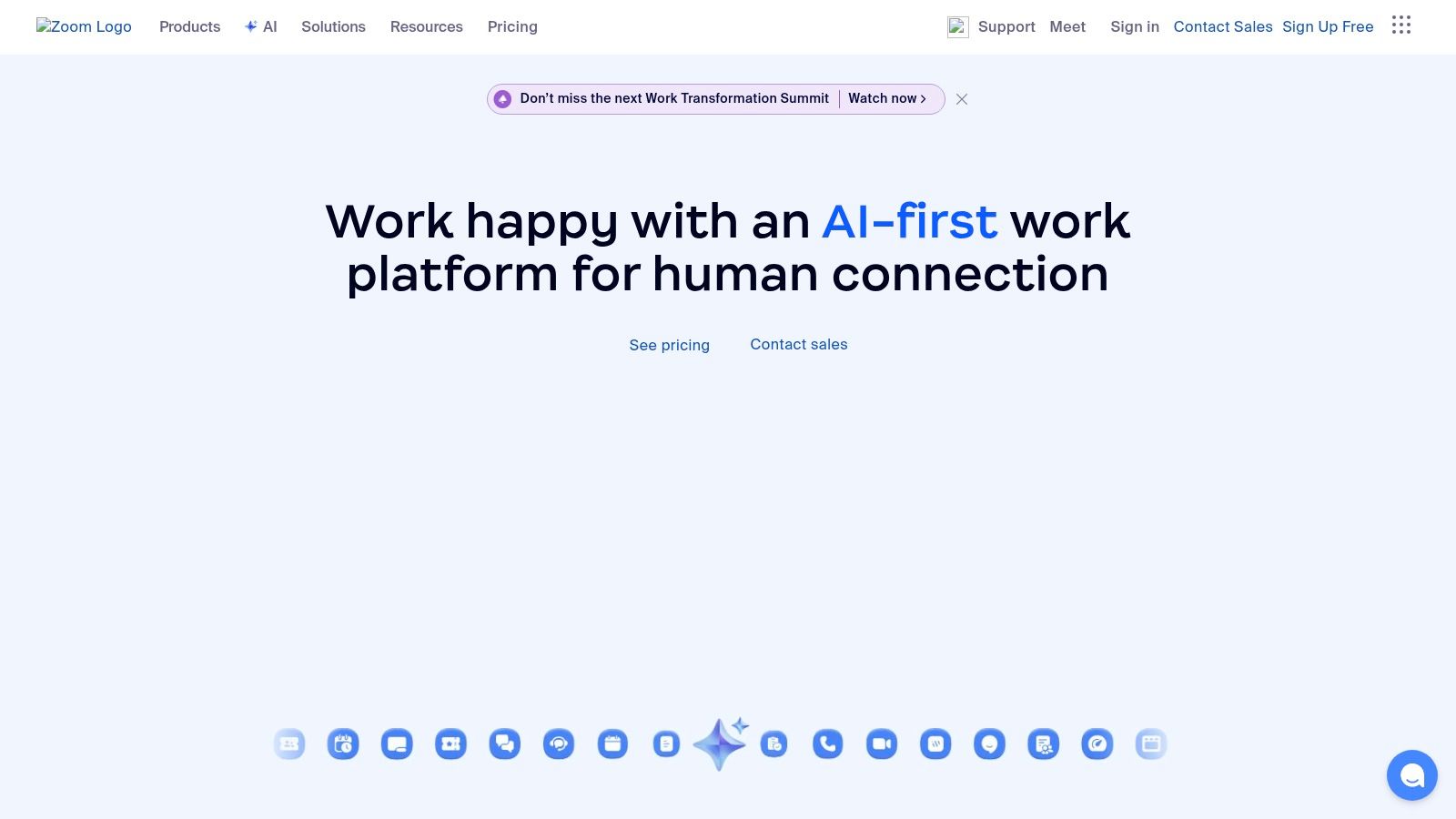
Zoom's extensive integration options with other applications weave it seamlessly into existing workflows. While security concerns were raised in the past, Zoom has significantly improved its security measures, addressing many initial concerns. For remote teams looking to enhance meeting engagement and interaction, exploring creative virtual team meeting ideas can be valuable. Learn more about...
Pros and Cons
Pros:
User-friendly interface.
Reliable performance.
Extensive integrations.
Robust features for meetings and webinars.
Cons:
Free plan has a 40-minute limit for group meetings.
Past security concerns, though largely addressed.
Practical Use Cases and Implementation
Zoom is highly effective for:
Team meetings.
Client presentations.
Webinars and online training.
Virtual conferences.
Implementation is simple: download the application or use the web client and start or join meetings. Zoom offers a free plan and various paid plans to accommodate different team sizes and needs.
Why Zoom Earns its Spot
Zoom's ease of use, reliability, and comprehensive features solidify its place as a leading remote collaboration tool. While the 40-minute limit on the free plan can be a constraint, its robust features and integrations make it a valuable asset for remote teams seeking seamless communication and collaboration. Check out Zoom at https://zoom.us/.
5. Asana
Asana empowers remote teams to organize, track, and manage their work effectively. Its diverse views (list, board, timeline) and customizable features cater to various project management styles, making it adaptable to different team needs and preferences. This flexibility is invaluable for remote teams who often require tailored approaches to collaboration. Learn more about how Asana can be used for remote project management here.
From setting goals and tracking progress to automating routine tasks, Asana streamlines workflows. Its reporting and analytics tools offer valuable insights into project performance, while integrations with other apps extend its functionality. This comprehensive approach ensures that remote teams have the resources they need to stay organized and productive.
Pros and Cons
Pros:
Flexible and customizable workflows.
User-friendly interface.
Strong integration capabilities.
Cons:
Can feel overwhelming for new users.
Limited features in the free version.
Practical Use Cases and Implementation
Asana is highly effective for:
Managing marketing campaigns.
Coordinating product launches.
Tracking software development projects.
Organizing design sprints.
Implementing Asana is straightforward. Start by creating a workspace and inviting your team. Define projects, break them down into tasks, and assign them to team members. Utilize the different views to visualize progress and identify potential roadblocks.
Why Asana Earns its Spot
Asana's adaptability and comprehensive features make it a valuable remote collaboration tool. While the sheer number of features can initially feel daunting, its user-friendly design helps teams quickly adapt. Its ability to centralize project management and streamline workflows makes it a valuable asset for remote teams seeking enhanced organization and productivity. Check out Asana at https://asana.com/.
6. Trello
Trello empowers remote teams with its visual project management approach. Using Kanban-style boards, lists, and cards, Trello helps organize and prioritize projects with remarkable flexibility. This visual workflow makes it easy to track progress and keep everyone on the same page, regardless of location. It's a powerful tool for managing everything from simple tasks to complex projects.
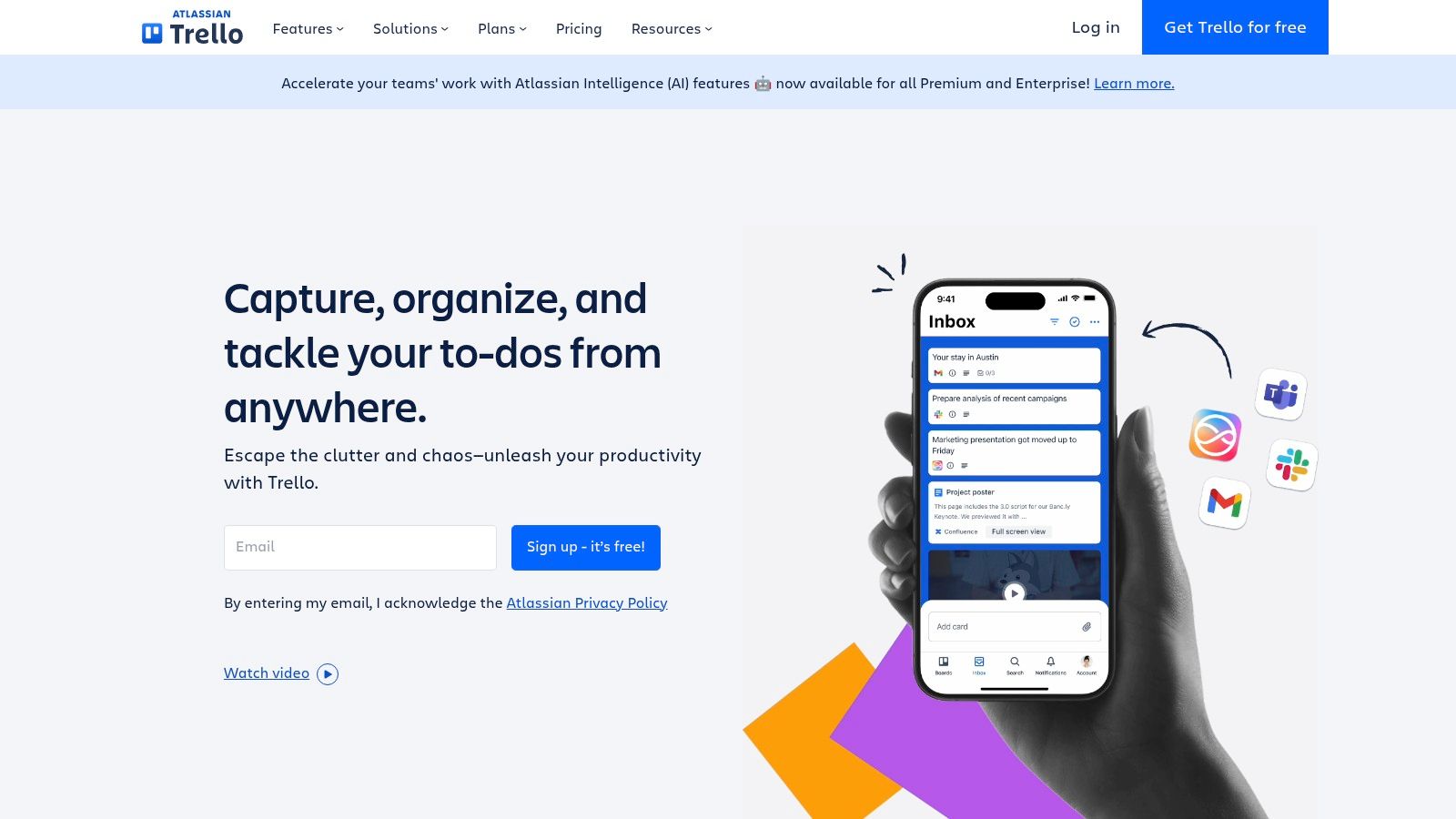
Trello's drag-and-drop functionality simplifies task management. Moving cards between lists visualizes workflow progression. Power-Ups extend Trello's capabilities with integrations like Slack, Google Drive, and more. These integrations weave Trello into existing workflows, crucial for remote teams. The collaboration features, including comments and attachments, facilitate seamless communication directly within the platform.
Pros and Cons
Pros:
Intuitive and easy-to-learn interface.
Highly customizable boards and workflows.
Generous free plan with ample features.
Seamless integration with popular tools via Power-Ups.
Mobile apps for convenient access.
Cons:
Can become complex for managing highly intricate projects.
Limited built-in reporting and analytics capabilities.
Advanced features often require a paid subscription.
Practical Use Cases and Implementation
Trello shines in various remote collaboration scenarios:
Managing marketing campaigns.
Tracking software development sprints.
Organizing content calendars.
Coordinating design projects.
Facilitating general task management for remote teams.
Implementation is straightforward. Create a board, populate it with lists representing workflow stages, and add cards for individual tasks. Invite your team and start collaborating. The free plan is a great starting point, while paid plans unlock additional features and team size limits.
Why Trello Earns its Spot
Trello's visual approach and flexible nature make it a valuable remote collaboration tool. Its simplicity combined with powerful integrations streamlines workflows and keeps teams connected. While it may not suit extremely complex projects, its ease of use and generous free plan make it an excellent starting point for remote teams seeking improved organization and collaboration. Check out Trello at https://trello.com/.
7. Miro
Miro transforms online brainstorming and planning with its infinite canvas and collaborative features, making it a valuable remote collaboration tool. It empowers remote teams to work together visually, replicating the energy of in-person whiteboard sessions. This dynamic environment fosters creativity and improves communication, crucial for remote teams spanning different time zones. Its versatility makes it suitable for various projects, from agile sprints to design thinking workshops.
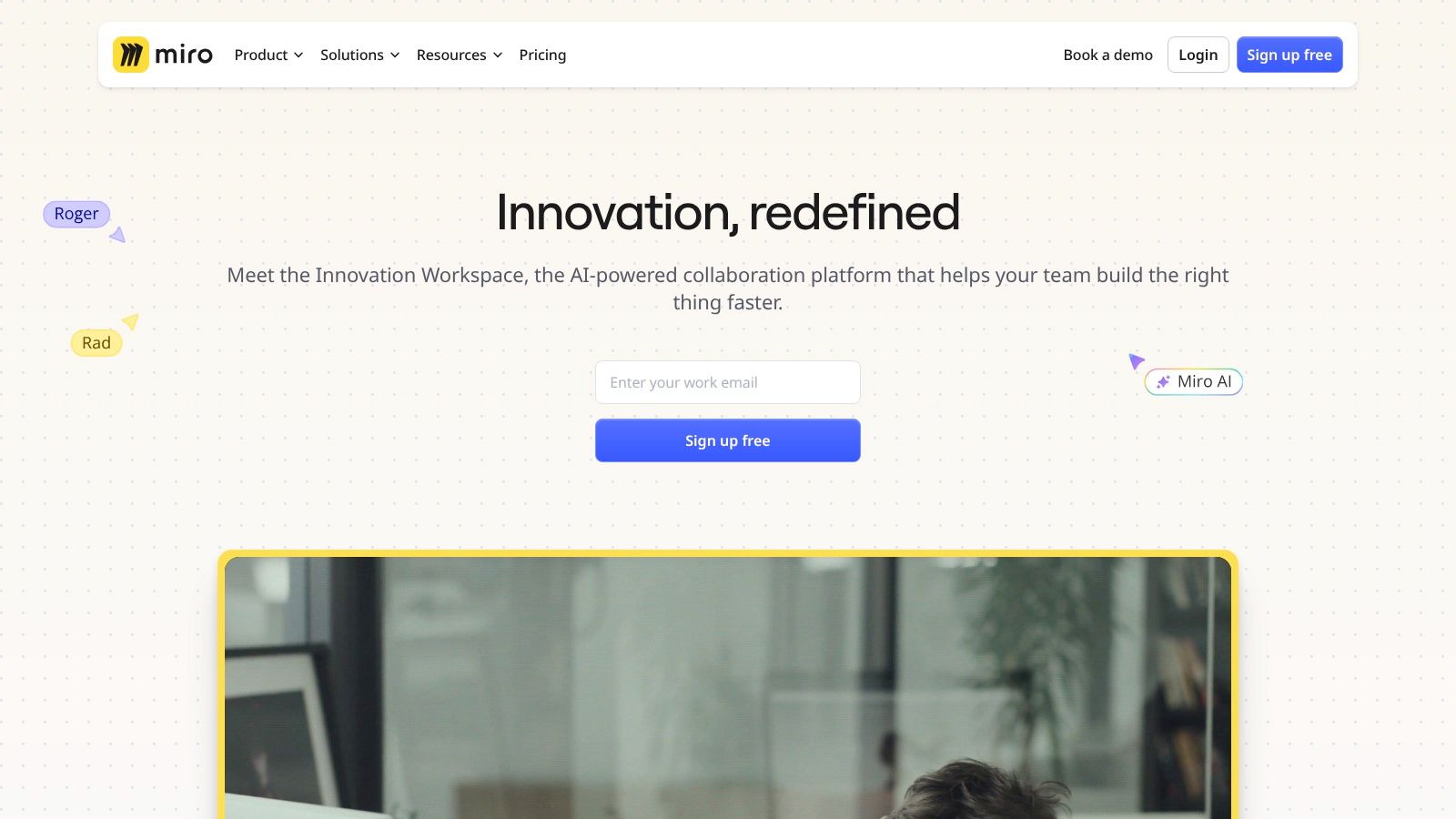
Pre-built templates for common use cases like mind mapping, Kanban boards, and customer journey maps accelerate project setup. Real-time collaboration features, including commenting, sticky notes, and even embedded video chat, enhance engagement and keep everyone on the same page. Integrations with popular tools like Slack, Jira, and Google Drive streamline workflows and prevent context switching.
Pros and Cons
Pros:
Highly interactive and visually engaging interface.
Versatile for various project types and team sizes.
Extensive template library and robust integration ecosystem.
Real-time collaboration features promote active participation.
Cons:
Can be resource-intensive, impacting performance on lower-powered devices.
Advanced features, like unlimited guests and private boards, require paid plans.
Practical Use Cases and Implementation
Miro excels in facilitating:
Brainstorming and ideation sessions.
Agile sprint planning and retrospectives.
Design thinking workshops and user research.
Project roadmapping and strategic planning.
Implementing Miro is straightforward. Create a free account, choose a template or start with a blank canvas, and invite your team. The intuitive interface makes it easy to learn and use, even for non-technical team members. While the free plan offers generous features, consider upgrading for larger teams or access to advanced functionalities.
Why Miro Earns its Spot
Miro stands out for its ability to bring visual collaboration to life in remote settings. Its interactive interface, rich feature set, and extensive integrations make it a powerful tool for teams seeking to boost creativity and streamline their workflows. While performance on lower-end devices can be a concern, its overall versatility and collaborative strength earn it a place among the top remote collaboration tools. Check out Miro at https://miro.com/.
8. Google Workspace
Google Workspace is a cornerstone for many remote teams. It's more than just a collection of tools; it's a comprehensive platform for collaboration, communication, and productivity. From drafting proposals in Docs to brainstorming in a shared Jamboard, Workspace enables seamless teamwork regardless of location. Its familiarity and ease of use lower the barrier to entry for new team members, minimizing the learning curve often associated with adopting new software.
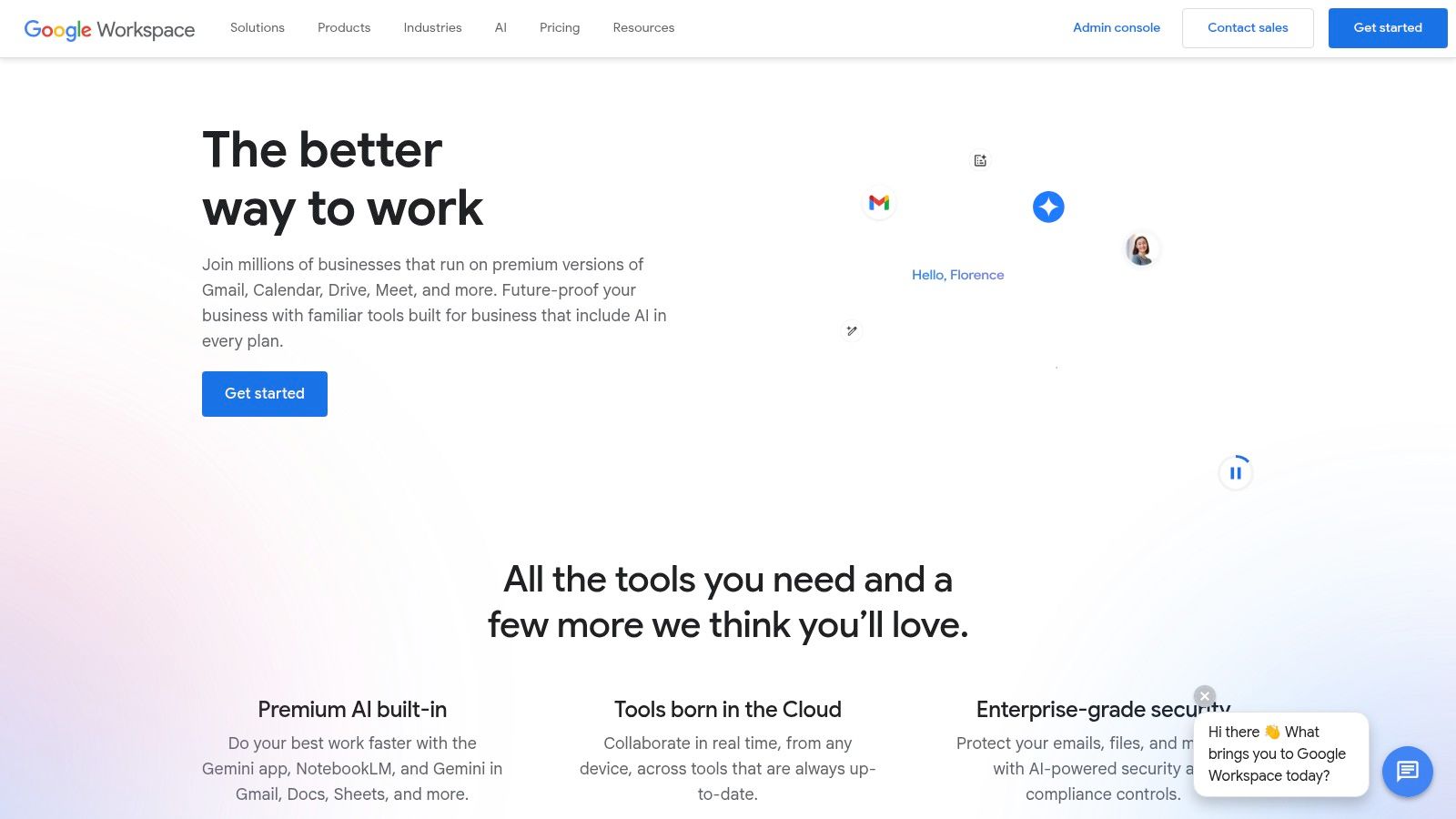
The real-time co-editing features in Docs, Sheets, and Slides are invaluable for remote collaboration. Seeing changes appear instantly and being able to work simultaneously eliminates version control headaches. Integrated communication through Gmail, Chat, and Meet streamlines workflows, keeping conversations connected to the relevant projects within the Workspace ecosystem. Shared Drives and robust search functionality ensure everyone can access the information they need, when they need it.
Pros and Cons
Pros:
Seamless integration between apps.
Real-time collaboration features.
Accessible from any device.
Cost-effective plans for various needs.
Robust administrative controls.
Cons:
Relies on internet connectivity for full functionality.
Offline features, while improving, are still limited.
Can become cluttered if not organized diligently.
Practical Use Cases and Implementation
Google Workspace is highly versatile and adaptable to diverse remote team needs:
Collaborative document creation and editing (proposals, reports, presentations).
Project management using Sheets and shared Drives.
Real-time communication and meetings via Meet and Chat.
Client collaboration and file sharing.
Implementation is straightforward. Sign up for a plan, invite your team members, and establish clear folder structures within shared Drives to maintain organization. Leverage the power of Spaces (formerly Rooms) in Google Chat to organize conversations by project or topic.
Why Google Workspace Earns its Spot
Google Workspace is a foundational tool for remote collaboration. Its comprehensive suite of integrated apps, real-time collaboration features, and accessibility make it an essential platform for remote teams. While the reliance on internet connectivity can be a minor drawback, the overall value and ease of use solidify Google Workspace's place as a top remote collaboration tool. Check out Google Workspace at https://workspace.google.com/.
9. Notion
Notion has become a cornerstone for many remote teams, acting as a central hub for everything from project management to documentation. Its strength lies in its flexibility. Notion allows you to build custom workspaces tailored to your team's specific needs, combining note-taking, databases, wikis, and project tracking into a single platform. This consolidation minimizes context switching between different apps, a major productivity boost for remote workers.
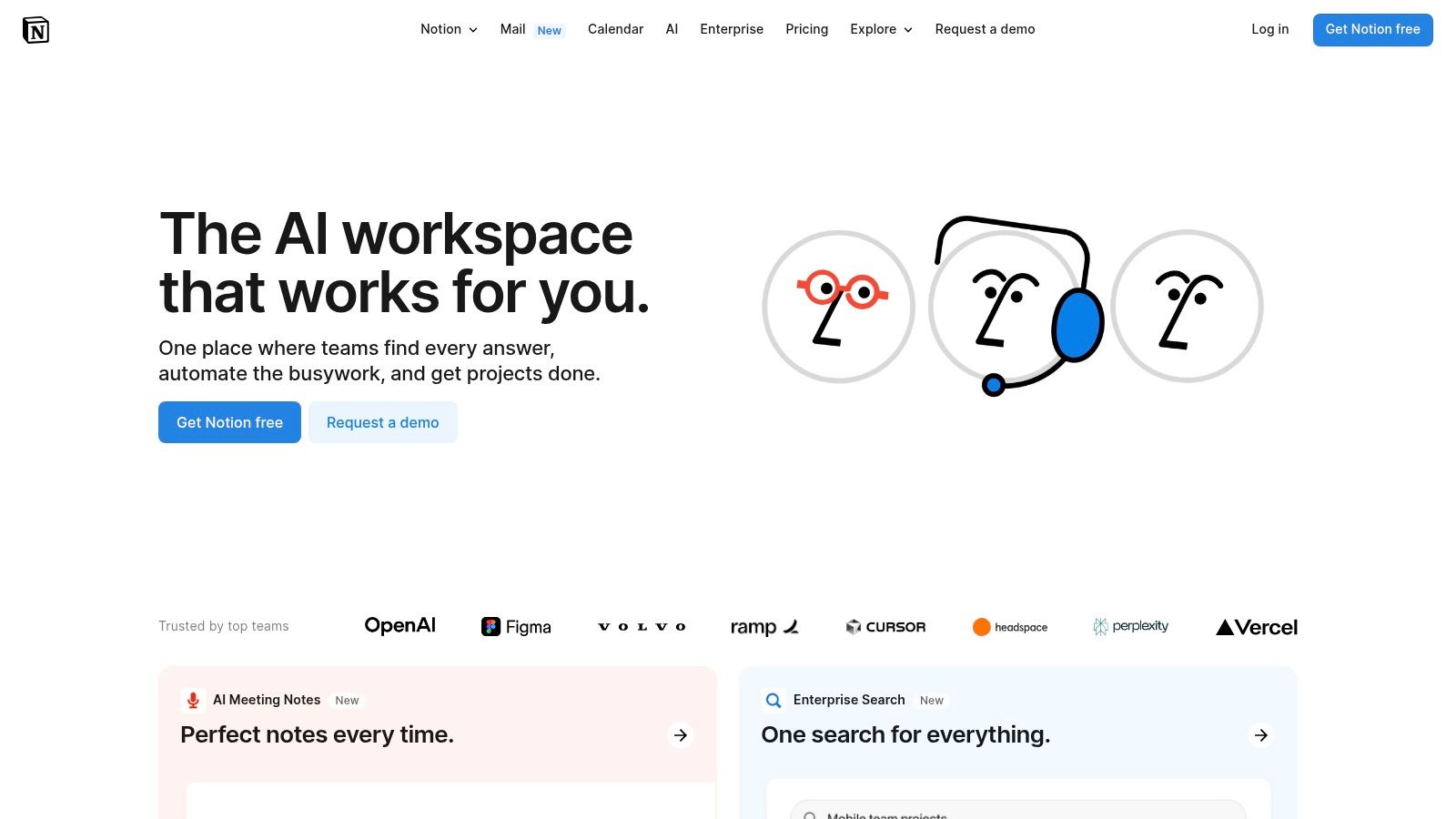
Notion's database functionality is particularly powerful for remote collaboration. Teams can create custom databases to track tasks, manage projects, or even build a company knowledge base. The different views (table, board, calendar, list) cater to diverse work styles and project needs. Real-time collaboration features, including commenting and @-mentions, keep everyone aligned, regardless of location.
Pros and Cons
Pros:
Highly customizable and adaptable to different team needs.
Consolidates multiple tools into one unified platform.
Intuitive interface and easy to learn basic features.
Offers a generous free plan for individuals and small teams.
Cons:
Can become complex for larger teams or intricate projects.
Limited integrations compared to more specialized tools.
Offline functionality, while available, can be limited.
Practical Use Cases and Implementation
Notion shines in scenarios where a centralized, flexible workspace is crucial. Consider using Notion for:
Project planning and task management.
Building a company wiki or internal knowledge base.
Meeting notes and documentation.
Content calendars and editorial workflows.
Implementing Notion effectively involves careful planning and structuring of your workspace. Start with a clear understanding of your team's needs and choose templates or build custom structures accordingly. The free plan is sufficient for initial exploration. Paid plans unlock more features like team collaboration and increased storage.
Why Notion Earns its Spot
Notion's all-in-one approach and customization options make it a valuable remote collaboration tool. While its flexibility can be a double-edged sword, with careful planning, Notion empowers teams to create a truly tailored workspace. This adaptability, combined with its intuitive interface, secures Notion's place in the remote toolkit. Check out Notion at https://www.notion.so/.
10. Basecamp
Basecamp consolidates project management and team communication, making it a practical remote collaboration tool. It organizes work into distinct projects, each containing to-do lists, message boards, schedules, and files. This centralized approach streamlines communication and keeps everyone on the same page, a crucial aspect of successful remote work. Basecamp's simplicity is its strength - it's designed to be intuitive and easy to use, even for non-technical team members.
Its flat-rate pricing model, regardless of team size, makes it budget-friendly for growing remote teams. Automatic check-in questions further enhance communication by prompting team members for updates, reducing the need for constant status meetings. Basecamp's focus on reducing email clutter is a boon for remote teams often overwhelmed by overflowing inboxes. It replaces scattered email threads with focused discussions within designated project areas.
Pros and Cons
Pros:
Simple and intuitive interface.
Flat-rate pricing.
Centralized project organization.
Automatic check-ins.
Reduces email clutter.
Cons:
Limited advanced project management features (compared to dedicated PM tools).
Fewer customization options than some competitors.
Practical Use Cases and Implementation
Basecamp is effective for:
Managing small to medium-sized projects.
Facilitating team communication and collaboration.
Tracking project progress and deadlines.
Storing project-related documents and files.
Implementation is straightforward: sign up, create a project, and invite your team. Basecamp's intuitive design requires minimal training. While suitable for various teams, it's especially beneficial for those transitioning from chaotic email-based workflows to a more organized system.
Why Basecamp Earns its Spot
Basecamp's simplicity and focus on clear communication make it a valuable remote collaboration tool. Its all-in-one approach and predictable pricing are attractive for budget-conscious teams. While it might lack the advanced features of specialized project management software, its ease of use and centralized platform contribute significantly to efficient remote teamwork. Check out Basecamp at https://basecamp.com/.
11. Monday.com
Monday.com positions itself as a work operating system (OS). It empowers remote teams to manage projects and workflows effectively. Its highly customizable nature makes it adaptable to diverse team needs, from marketing campaigns to software development sprints. This flexibility is a major draw for remote teams requiring a single platform for various tasks.
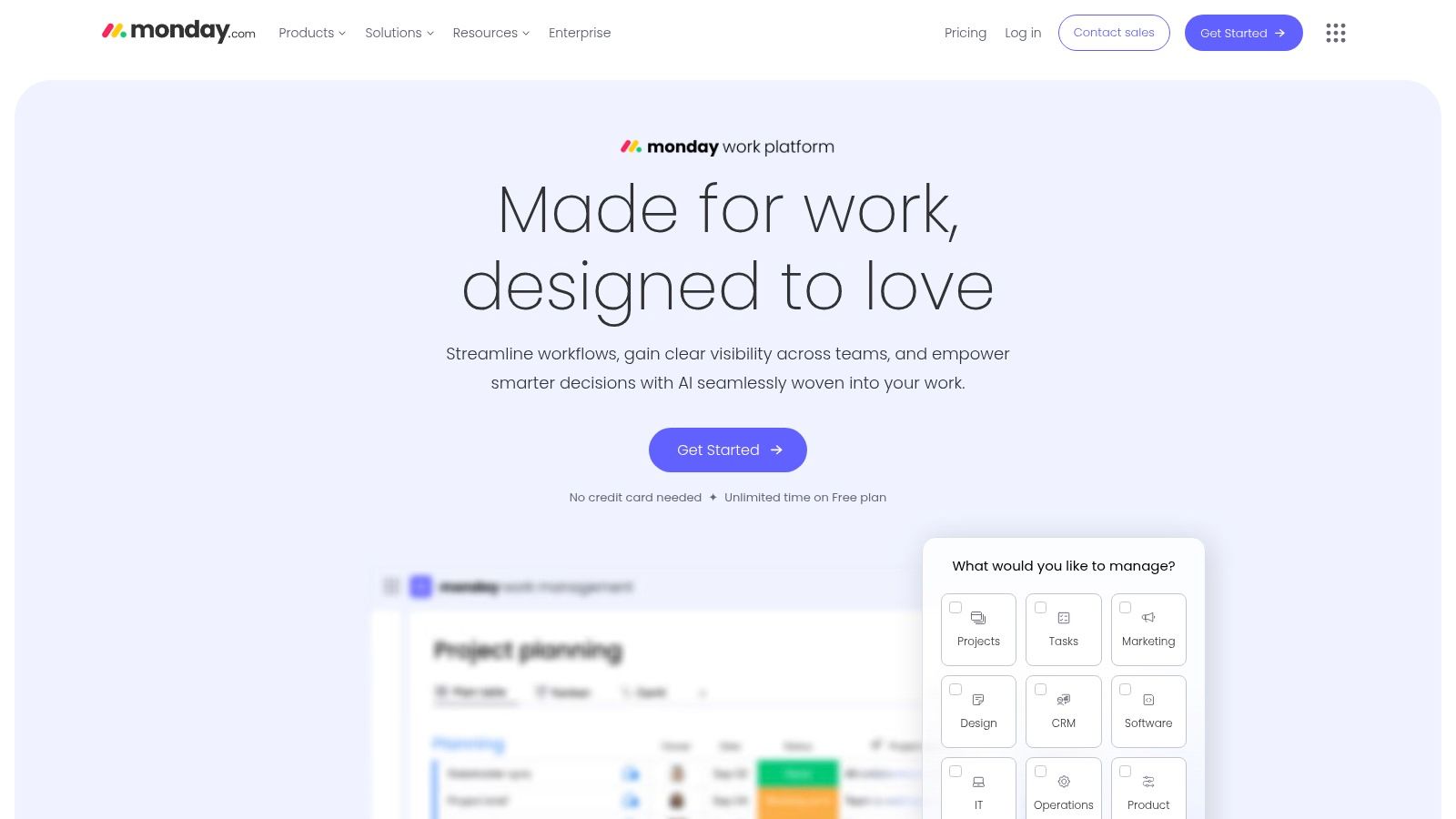
Its drag-and-drop interface simplifies workflow creation. Multiple project views, including Kanban, Gantt, and calendar, provide valuable perspectives on project progress. Automated repetitive tasks free up team members to focus on higher-value work. Built-in time tracking and reporting tools offer insights into project timelines and resource allocation. Furthermore, its extensive integrations with other applications make it a central hub for remote team activities.
Pros and Cons
Pros:
Highly customizable workflows.
User-friendly interface with visual project tracking.
Strong integration capabilities with numerous apps.
Automation features for increased efficiency.
Cons:
Pricing can be a barrier for smaller teams or startups.
Feature richness can sometimes feel overwhelming for new users.
Practical Use Cases and Implementation
Monday.com excels in managing various remote team projects:
Marketing campaign planning and execution.
Software development sprints and bug tracking.
Sales pipeline management and CRM integration.
Content calendar management and editorial workflows.
Implementation involves selecting a template or building a custom board. Teams should invest time upfront in configuring workflows to maximize the platform's potential. While user-friendly, some training might be beneficial for complex automations.
Why Monday.com Earns its Spot
Monday.com's adaptability makes it a powerful remote collaboration tool. Its visual interface, combined with robust features and extensive integrations, offers a centralized platform for various team needs. Though pricing may be a consideration for smaller teams, its value proposition for managing complex projects and workflows makes it a valuable addition to any remote team's toolkit. Check out Monday.com at https://monday.com/.
Remote Collaboration Tools Comparison
Platform | Core Features / Characteristics | User Experience / Quality ★ | Value Proposition 💰 | Target Audience 👥 | Unique Selling Points ✨ |
|---|---|---|---|---|---|
🏆 Beep | Visual feedback on live sites, auto screenshots, kanban board | 4.9⭐ - Intuitive UI, fast setup | Saves hours, free trial, no CC needed | Product managers, designers, devs | Visual annotation on live websites, seamless integrations |
Slack | Channel messaging, threaded chats, calls, 2400+ apps | ★★★★☆ - Clean UI, customizable | Free with limits, paid plans vary | Teams needing organized comms | Massive app ecosystem, flexible notifications |
Microsoft Teams | Chat, video, file sharing, MS 365 integration | ★★★★☆ - Secure, robust video/audio | Included in MS 365 subscriptions | Enterprises, MS 365 users | Deep MS 365 integration, advanced security |
Zoom | HD video/audio, screen share, breakout rooms | ★★★★☆ - Easy to use, reliable | Free limited to 40 mins, paid plans | Businesses needing video meetings | Large participant support, webinars |
Asana | Task & project mgmt, multiple views, automation | ★★★★☆ - Intuitive, customizable | Free limited, paid tiers for features | Teams managing projects | Robust task automation and reporting |
Trello | Kanban boards, drag/drop, Power-Ups | ★★★★☆ - Simple, visual task mgmt | Free tier substantial | Small to medium teams | Easy visual workflow, flexible and free tier |
Miro | Collaborative whiteboard, real-time, templates | ★★★★☆ - Engaging, versatile | Free limited, premium plans available | Creative teams, planners | Infinite canvas, rich integrations |
Google Workspace | Docs, Sheets, Drive, Gmail, Meet | ★★★★☆ - Seamless cloud collaboration | Subscription-based | All sized teams, remote workers | Full productivity suite with real-time collaboration |
Notion | Note-taking, databases, templates | ★★★★☆ - Highly customizable | Free tier, paid for advanced features | Individuals, teams organizing work | All-in-one workspace combining docs & projects |
Basecamp | To-dos, message boards, schedules | ★★★☆☆ - Simple, flat-rate pricing | Flat-rate pricing | Small teams, startups | Predictable cost, reduces email clutter |
Monday.com | Custom workflows, multiple views, automation | ★★★★☆ - Visual tracking, customizable | Paid plans, higher cost for small teams | Teams managing workflows | Highly customizable project & workflow OS |
Empowering Remote Teams for Peak Performance
This in-depth exploration of remote collaboration tools has highlighted the diverse landscape of platforms available to today's distributed teams. From communication hubs like Slack and Microsoft Teams to project management powerhouses like Asana and Trello, and visual collaboration spaces like Miro and Google Workspace, the options are extensive. We've delved into the nuances of each tool, exploring their strengths, limitations, and ideal use cases, offering practical insights gleaned from real-world usage.
Key Takeaways for Effective Remote Collaboration
Choosing the right remote collaboration tools is crucial for success in today's distributed work environment. Here's a recap of key considerations:
Communication is Key: Tools like Slack and Microsoft Teams excel at streamlining communication, but consider your team's size and communication style when making a choice. Beep offers a unique approach, consolidating various messaging platforms, which can be a game-changer for teams juggling multiple communication channels.
Project Management is Essential: Asana, Trello, Monday.com, and Basecamp each offer distinct approaches to project management. Consider your team's workflow, project complexity, and reporting needs.
Visual Collaboration Fosters Innovation: Miro and Google Workspace empower teams to brainstorm, visualize ideas, and collaborate creatively. These tools are particularly valuable for design thinking, workshops, and strategic planning.
Integration and Customization: A seamless workflow hinges on integrations. Evaluate how well each tool integrates with your existing tech stack to maximize efficiency.
Implementing Remote Collaboration Tools Effectively
Successfully integrating new tools requires careful planning and execution.
Start with a Needs Assessment: Identify your team's specific pain points and prioritize tools that address those challenges.
Pilot and Iterate: Don't roll out every tool at once. Pilot test with a small group and gather feedback before wider implementation.
Training and Support: Provide adequate training and ongoing support to ensure team members embrace and effectively utilize the new tools.
Foster a Culture of Collaboration: Remember that tools are enablers, not solutions. Cultivate a culture of open communication, transparency, and shared responsibility.
Choosing the Right Tool for Your Team
The "perfect" remote collaboration tool doesn't exist, but the right tool for your team does. Consider these factors:
Team Size and Structure: A small startup may thrive with a simple solution like Slack, while a large enterprise might require a more robust platform like Microsoft Teams.
Budget: Explore pricing models and choose a solution that aligns with your budget. Many tools offer free versions with limited functionality.
Specific Needs: Prioritize features that address your team's unique requirements, whether it's video conferencing, file sharing, or project management.
Effective remote collaboration hinges on more than just the right tools; it demands a conscious effort to build a connected and collaborative team culture. By carefully selecting and implementing the right remote collaboration tools and fostering a supportive environment, you can empower your remote team to achieve peak performance and reach its full potential.
Looking to streamline your team's communication across different platforms? Beep brings all your messaging apps into one unified inbox, simplifying communication and enhancing collaboration for remote teams. Learn more and try Beep today: Beep

.png)
Comments